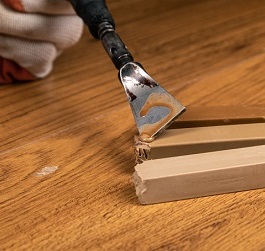Care of Wooden Flooring
Reading time: 5 minutes
How do you maintain wooden floors?
Solid wood floors are incredibly tough and hard-wearing, which is one of the key benefits of having them in the first place. It’s no wonder that you’ll still find original oak floorboards in older properties because of their longevity. However, they still require general care and attention to avoid unnecessary damage or even distortion.
Preventing scratches and dents on wooden flooring
Wooden flooring is made to last a long time, so it stands to reason that it will have to withstand being walked on continually, as well as the placement and movement of furniture. Hard-soled shoes and heels can cause dents, while some furniture, especially heavy furniture, can also be damaging.
This can be remedied by keeping shoes off, and even buying rubber protectors for chair and table legs. Of course, there’s always the addition of a strategically-placed rug that can add an extra layer of protection when placed under certain furniture.
Can water damage wooden floors?
Water can cause a lot of problems for wooden flooring. If left too long, or if an ongoing damp problem is left unattended, the wood can warp and even begin to rot. That’s why it’s always best to clean up any spillages right away. If there are any issues with damp, these should also be fixed quickly.
New flooring should have a protective coating to reduce damage from water spills, and it is possible to buy further treatments to give flooring a protective layer. However, it’s still a good idea to act on any spillages as soon as possible, as these protective layers only limit moisture damage and can’t completely prevent it.
With the development of engineered wood flooring, which is made up of layers of timber and a solid wood top layer, these can be a little more resistant to moisture. But it’s still a good idea to avoid spilling and pooling liquid where possible. This is because the top layer is still made from wood, so can potentially warp over time from continual exposure to water.
What is the best treatment for wooden flooring?
There are many different types of treatments and sealants for wooden floors, each with their own benefits and downsides. We’re going to look at some of these treatments as a good example of workable, practical solutions for protecting your flooring.
However, remember that while we can provide some advice for available products, always check manufacturers’ instructions for guidance.

Can I use polyurethane sealant?
Polyurethane sealants offer a tough coating to wood, and can be quite fast drying but sometimes require more than one coat. This varnish is applied by brush and is available in gloss, matt and satin finishes. When you see very shiny new wood flooring, it has usually been given a high-gloss polyurethane seal.
While this finish makes it easier to keep clean, it doesn’t make the surface completely scratch- or mark-resistant, and can even make existing marks slightly more obvious.
Is it best to varnish or wax a wooden floor?
To answer this question, let’s go through the differences between varnish and wax. Firstly, varnish is a coating that sets on the surface of the wood, forming a protective layer. Wax seeps into the wood, and creates a sheen when polished.
The main things to consider when choosing between varnish or wax is durability over style. Varnish is transparent, so you still see the wood grain, giving a uniform coat that can ‘fill in’ some of the grain. Wax isn’t quite as protective, but will still give all the texture and tone of the wood. Also, wax needs a bit more elbow grease when applying, requiring more intensive rubbing into the wood. Varnish is easier to apply by brush.
Be careful not to apply wax or coatings to new wooden floors. They should already have plenty of their factory sealed layer on them, so won’t need much more added. Also, giving them a further coat of wax or varnish can make new flooring dangerously slippery.
How do you clean wooden floors?
The main trick for cleaning solid wood flooring is to do it often, at least once a month for a thorough sweeping. Vacuum more frequently, with the brushes down on the vacuum cleaner’s nozzle, keeping the floor free of dust and dirt.
For a deeper clean, you might want to use a mop and bucket, but do keep in mind that excess water can lead to damage. Use hot water so that it evaporates quickly and don’t allow it to pool for too long. If you’ve finished mopping and you see patches of water, give them a wipe up with a cloth.
We hope this has helped answer your questions about protecting and cleaning wooden floors, to give them a longer life. If you want more flooring inspiration and advice, please read our other articles. We’re always adding more helpful guides, so check back for updates soon!
Disclaimer: The information contained on this page is intended as an overall introduction and is not intended as specific advice from a qualified professional. Travis Perkins aims to avoid, but accepts no liability, in the case that any information stated is out of date.












